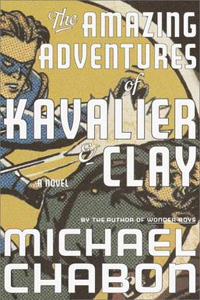Michael Chabon’s “The Amazing Adventures of Kavalier & Clay” (2000) has always been, in the back of my mind, my pick for the Great American Novel. I feel that more strongly on my second read. Working in historical fiction, Chabon blends the birth of comic-book superheroes, Jews’ plight during Hitler’s predations, the forced secrecy of gay people, the rise of the suburbs, and a touch of supernaturalism into a sprawling yet intimate portrait of the 1940s.
The 639 pages are always engrossing, even though – and sometimes because – Chabon goes off on wonderfully detailed tangents about (among other things) stage illusionist tricks, the political/money games of getting innocents away from the war’s center, and the psychosis-inducing emptiness of frigid Antarctica.
Around the world
The focal characters start as young men: Joe Kavalier, who escapes from Prague to New York, forced to leave his parents and brother behind; and his cousin, Sammy Clay, a dreaming Brooklynite. Later, Rosa Saks enters as Joe’s girlfriend, and Sammy is secretly drawn to Tracy Bacon, a real-life answer to his superhero co-creation with his cousin: the Escapist.

“The Amazing Adventures of Kavalier & Clay” (2000)
Author: Michael Chabon
Genre: Historical fiction
Setting: 1940s, New York City
Note to readers: The Book Club Book Report series features books I’m reading for my book club, Brilliant Bookworms.
Similar to how TV’s “The Marvelous Mrs. Maisel” shows a comedienne’s rise through the East Coast comedy scene in the 1950s, “K&C” tells of a creative duo’s rise through comic books’ Golden Age of the 1940s. “Maisel” is loosely based on Joan Rivers, but really it uses history as a stage for a more robust “What if?” What if there was a woman comic who shook things up even more?
“K&C” is loosely based on “Superman’s” Siegel and Shuster, especially when Kavalier and Clay make a big contractual mistake by letting their boss, Sheldon Anapol, have the rights to the Escapist. But “Superman” and DC Comics exist in the novel’s world, as does Timely (later Marvel) Comics. “The Escapist” and Empire Comics slot in alongside them, making the birth-of-superheroes era even more colorful. The Escapist is drawn (by Joe) in the traditional square-jawed manner, and he fights (via Sammy’s storytelling, influenced by Joe) against Nazis.
Even in describing the Escapist secondhand (aside from a fascinating chapter where Joe and the Escapist become one real/fictional combo), Chabon creates such a vibrant character that I’d pick up trade paperbacks of the old comics if he was a real part of comic-book history.
At the same time, the Escapist underscores the book’s theme: Joe must escape from Hitler’s persecutions, but he’s still trapped by his desire to kill actual Germans, rather than merely doing so in comic books. Sammy is trapped by being gay in a society that doesn’t accept that. He doesn’t know how to live free.

The value of escapism
As a conclusive conflict, Chabon incorporates the 1954 United States Senate Subcommittee on Juvenile Delinquency and its galvanizing book, “Seduction of the Innocent” by Frederic Wertham. The charge was that Batman and Robin and other hero/sidekick pairs encourage gay relationships.
More broadly – and if possible, more absurdly – the committee argues that escapism in any form is bad for American youths. It’s juicy reading, but at the same time Chabon smoothly understates this issue. The author doesn’t work at making the Subcommittee evil or ridiculous; he just lets the reader take it for granted.
“K&C” is so deeply a character piece by this point that we don’t need theoretical or anecdotal convincing that escapism is good for people’s sanity. When I say this is an intimate character study, I’m not saying it lightly. We’re told that Joe has an erection the entire time he’s drawing issues of “Luna Moth,” when he’s embarking on a courtship of Rosa, his muse for this early female superhero. Peppered throughout “K&C,” I learned far more than I cared to about what the main characters’ crotches smell like.
Chabon’s novel is so richly loaded with threads, though, that a reader can easily move on from that to, say, an analysis of how Joe is inspired by “Citizen Kane” to make his panels more cinematically kinetic.
I came into this book already liking comics and superheroes. However, I’m not at super-geek level in this aspect of pop culture. When Chabon’s passion soaks into me, I have to give his prose credit more so than any superhero interest I brought to the table myself. I’m guessing that even a reader who wouldn’t pay the original cover price of 10 cents to read “Action Comics” No. 1 will get swept up in Chabon’s heartfelt love of the medium.
Rosy Golden Age
“K&C” has extremely dark moments (it is, after all, set during Hitler’s rein) and is nostalgically melancholy overall. But it’s also invigorating and leaves a reader feeling OK even about self-serving people such as Anapol and his fellow executives at Empire Comics, the stand-ins for the DC suits who schemed the naïve Siegel and Shuster.
One arguable misfire amid Chabon’s rose-colored look at The Golden Age is that Stan Lee and Bob Kane enter (fortunately only briefly) as pure-hearted geniuses of the era, amiably chatting at the Big Apple hangout spot for writers and artists.
Lee, the co-creator of most Marvel heroes, and Kane, the co-creator of Batman, have in the 21st century become more exposed for their underselling of their co-creators (Jack Kirby and Bill Finger, respectively). Chabon’s laudatory writings play as a little naïve now. Granted, he does dedicate the entire novel to Kirby, but Finger goes unmentioned.
That quibble is a needle in a haystack of the literary genius that is “The Amazing Adventures of Kavalier & Clay.” Through two Everymen who are naturals at storytelling and drawing, Chabon crafts a lively portrait of the 1940s and the life-saving, life-affirming escapism provided by its various Supermen.

